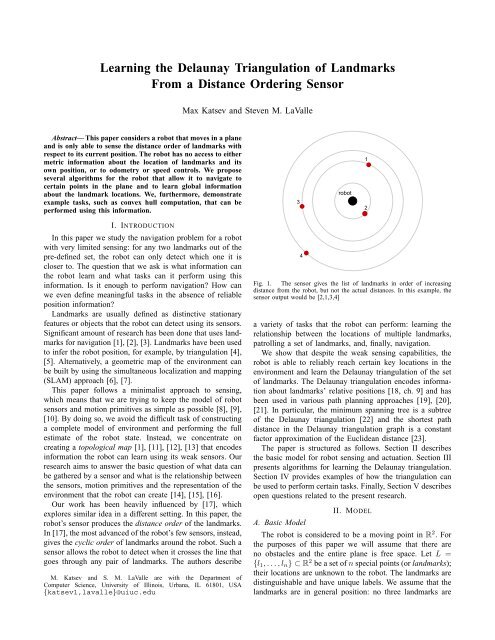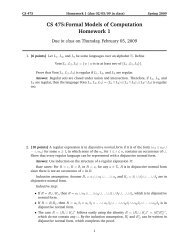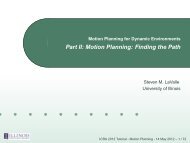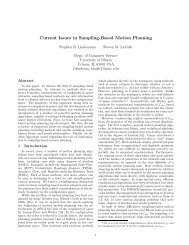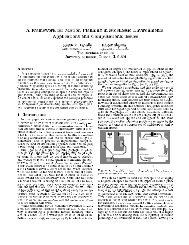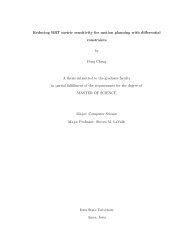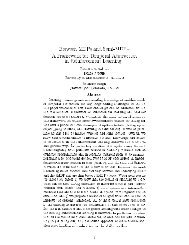Learning the Delaunay Triangulation of Landmarks From a ... - LaValle
Learning the Delaunay Triangulation of Landmarks From a ... - LaValle
Learning the Delaunay Triangulation of Landmarks From a ... - LaValle
You also want an ePaper? Increase the reach of your titles
YUMPU automatically turns print PDFs into web optimized ePapers that Google loves.
<strong>Learning</strong> <strong>the</strong> <strong>Delaunay</strong> <strong>Triangulation</strong> <strong>of</strong> <strong>Landmarks</strong><strong>From</strong> a Distance Ordering SensorMax Katsev and Steven M. <strong>LaValle</strong>Abstract— This paper considers a robot that moves in a planeand is only able to sense <strong>the</strong> distance order <strong>of</strong> landmarks withrespect to its current position. The robot has no access to ei<strong>the</strong>rmetric information about <strong>the</strong> location <strong>of</strong> landmarks and itsown position, or to odometry or speed controls. We proposeseveral algorithms for <strong>the</strong> robot that allow it to navigate tocertain points in <strong>the</strong> plane and to learn global informationabout <strong>the</strong> landmark locations. We, fur<strong>the</strong>rmore, demonstrateexample tasks, such as convex hull computation, that can beperformed using this information.I. INTRODUCTIONIn this paper we study <strong>the</strong> navigation problem for a robotwith very limited sensing: for any two landmarks out <strong>of</strong> <strong>the</strong>pre-defined set, <strong>the</strong> robot can only detect which one it iscloser to. The question that we ask is what information can<strong>the</strong> robot learn and what tasks can it perform using thisinformation. Is it enough to perform navigation? How canwe even define meaningful tasks in <strong>the</strong> absence <strong>of</strong> reliableposition information?<strong>Landmarks</strong> are usually defined as distinctive stationaryfeatures or objects that <strong>the</strong> robot can detect using its sensors.Significant amount <strong>of</strong> research has been done that uses landmarksfor navigation [1], [2], [3]. <strong>Landmarks</strong> have been usedto infer <strong>the</strong> robot position, for example, by triangulation [4],[5]. Alternatively, a geometric map <strong>of</strong> <strong>the</strong> environment canbe built by using <strong>the</strong> simultaneous localization and mapping(SLAM) approach [6], [7].This paper follows a minimalist approach to sensing,which means that we are trying to keep <strong>the</strong> model <strong>of</strong> robotsensors and motion primitives as simple as possible [8], [9],[10]. By doing so, we avoid <strong>the</strong> difficult task <strong>of</strong> constructinga complete model <strong>of</strong> environment and performing <strong>the</strong> fullestimate <strong>of</strong> <strong>the</strong> robot state. Instead, we concentrate oncreating a topological map [1], [11], [12], [13] that encodesinformation <strong>the</strong> robot can learn using its weak sensors. Ourresearch aims to answer <strong>the</strong> basic question <strong>of</strong> what data canbe ga<strong>the</strong>red by a sensor and what is <strong>the</strong> relationship between<strong>the</strong> sensors, motion primitives and <strong>the</strong> representation <strong>of</strong> <strong>the</strong>environment that <strong>the</strong> robot can create [14], [15], [16].Our work has been heavily influenced by [17], whichexplores similar idea in a different setting. In this paper, <strong>the</strong>robot’s sensor produces <strong>the</strong> distance order <strong>of</strong> <strong>the</strong> landmarks.In [17], <strong>the</strong> most advanced <strong>of</strong> <strong>the</strong> robot’s few sensors, instead,gives <strong>the</strong> cyclic order <strong>of</strong> landmarks around <strong>the</strong> robot. Such asensor allows <strong>the</strong> robot to detect when it crosses <strong>the</strong> line thatgoes through any pair <strong>of</strong> landmarks. The authors describeM. Katsev and S. M. <strong>LaValle</strong> are with <strong>the</strong> Department <strong>of</strong>Computer Science, University <strong>of</strong> Illinois, Urbana, IL 61801, USA{katsev1,lavalle}@uiuc.eduFig. 1. The sensor gives <strong>the</strong> list <strong>of</strong> landmarks in order <strong>of</strong> increasingdistance from <strong>the</strong> robot, but not <strong>the</strong> actual distances. In this example, <strong>the</strong>sensor output would be [2,1,3,4]a variety <strong>of</strong> tasks that <strong>the</strong> robot can perform: learning <strong>the</strong>relationship between <strong>the</strong> locations <strong>of</strong> multiple landmarks,patrolling a set <strong>of</strong> landmarks, and, finally, navigation.We show that despite <strong>the</strong> weak sensing capabilities, <strong>the</strong>robot is able to reliably reach certain key locations in <strong>the</strong>environment and learn <strong>the</strong> <strong>Delaunay</strong> triangulation <strong>of</strong> <strong>the</strong> set<strong>of</strong> landmarks. The <strong>Delaunay</strong> triangulation encodes informationabout landmarks’ relative positions [18, ch. 9] and hasbeen used in various path planning approaches [19], [20],[21]. In particular, <strong>the</strong> minimum spanning tree is a subtree<strong>of</strong> <strong>the</strong> <strong>Delaunay</strong> triangulation [22] and <strong>the</strong> shortest pathdistance in <strong>the</strong> <strong>Delaunay</strong> triangulation graph is a constantfactor approximation <strong>of</strong> <strong>the</strong> Euclidean distance [23].The paper is structured as follows. Section II describes<strong>the</strong> basic model for robot sensing and actuation. Section IIIpresents algorithms for learning <strong>the</strong> <strong>Delaunay</strong> triangulation.Section IV provides examples <strong>of</strong> how <strong>the</strong> triangulation canbe used to perform certain tasks. Finally, Section V describesopen questions related to <strong>the</strong> present research.A. Basic ModelII. MODELThe robot is considered to be a moving point in R 2 . For<strong>the</strong> purposes <strong>of</strong> this paper we will assume that <strong>the</strong>re areno obstacles and <strong>the</strong> entire plane is free space. Let L ={l 1 ,...,l n } ⊂ R 2 be a set <strong>of</strong>nspecial points (or landmarks);<strong>the</strong>ir locations are unknown to <strong>the</strong> robot. The landmarks aredistinguishable and have unique labels. We assume that <strong>the</strong>landmarks are in general position: no three landmarks are
(a) Projections <strong>of</strong> both direction fields on<strong>the</strong> bisector have <strong>the</strong> same direction. Therobot will move in that direction until itreaches point AFig. 2. Perpendicular bisectors split <strong>the</strong> environment into polygonalpreimages. Each preimage can be uniquely identified by <strong>the</strong> sensor outputwhen <strong>the</strong> robot is inside <strong>the</strong> region. Some preimage labels are omitted forclaritycollinear, no four landmarks are cocircular, and no landmarkis equidistant from two o<strong>the</strong>r landmarks.Let r ∈ R 2 be <strong>the</strong> current robot position. The state spacefor <strong>the</strong> robot is defined as(b) Projections <strong>of</strong> both direction fields on <strong>the</strong>bisector have opposite directions. The robotbehavior is not clearly defined.X = R 2 ×E,in which E ⊂ R 2n is a set <strong>of</strong> all possible landmarkconfigurations.The robot is equipped with a distance ordering sensorthat returns <strong>the</strong> sequence <strong>of</strong> landmark labels ordered by <strong>the</strong>distance relative to <strong>the</strong> current robot position in ascendingorder (see Fig. 1) and additional information about landmarksthat are equidistant from <strong>the</strong> robot. Such a sensor can beimplemented, for example, by comparing <strong>the</strong> strength <strong>of</strong>radio signals transmitted by <strong>the</strong> landmarks.The robot is able to execute two motion primitives:TOWARD(l) and AWAY(l). TOWARD(l) results in <strong>the</strong> robotmoving in a straight line in <strong>the</strong> direction <strong>of</strong> <strong>the</strong> landmarklabeled l, whereas AWAY(l) moves <strong>the</strong> robot in <strong>the</strong> oppositedirection (AWAY(l) is undefined when <strong>the</strong> robot is at l).Additionally, TOWARD(l) terminates when <strong>the</strong> robot arrivesat l. Note that <strong>the</strong>se motion primitives do not provide <strong>the</strong>robot with any information about <strong>the</strong> relationship betweendirections to multiple landmarks.B. Additional ConsiderationsThe distance ordering sensor can be defined by a sensormappingh : X → S n ×P n−1 ,in which S n is a set <strong>of</strong> all possible permutations <strong>of</strong> n distinctelements and P n−1 is <strong>the</strong> powerset <strong>of</strong> {1,...,n − 1}. Thefirst part <strong>of</strong> <strong>the</strong> output lists <strong>the</strong> landmarks in <strong>the</strong> order <strong>of</strong>ascending distance to <strong>the</strong> robot. The second part encodesgroups <strong>of</strong> landmarks with equal distances to <strong>the</strong> current robotlocation: if it contains index i, <strong>the</strong>n distances to <strong>the</strong> i-thand i + 1-th closest landmarks are equal. For example, ifh(r,E) = ((l 4 ,l 2 ,l 1 ,l 3 ),{1,2}), <strong>the</strong>n, in <strong>the</strong> configurationE, <strong>the</strong> distances from r to l 4 , l 2 , and l 1 are equal and smallerthan <strong>the</strong> distance to l 3 .(c) We resolve <strong>the</strong> ambiguity by introducing a sensor reaction delay(dotted curves show where <strong>the</strong> sensor output changes after <strong>the</strong> robothas crossed <strong>the</strong> bisector). The robot will move in <strong>the</strong> directioncorresponding to <strong>the</strong> larger projection <strong>of</strong> <strong>the</strong> direction field on <strong>the</strong>bisector (in <strong>the</strong> direction <strong>of</strong> point C, in this example).Fig. 3.Various robot behavior at <strong>the</strong> boundary between preimagesAlternatively, <strong>the</strong> sensor output can be encoded as a linearorder relation “closer than or equidistant to” on <strong>the</strong> set <strong>of</strong>landmarks L that can be represented as an n×n matrix wi<strong>the</strong>lements ±1 that satisfies certain properties (for example,one <strong>of</strong> <strong>the</strong>m is to be antisymmetric).This mapping decomposes <strong>the</strong> plane into preimages: regionsin which <strong>the</strong> sensor output is constant. For <strong>the</strong> distanceordering sensor, <strong>the</strong> preimages are polygons created by <strong>the</strong>perpendicular bisectors (simply bisectors in <strong>the</strong> future) <strong>of</strong>pairs <strong>of</strong> <strong>the</strong> landmarks (see Fig. 2), <strong>the</strong> bisectors <strong>the</strong>mselves,and <strong>the</strong> intersection points <strong>of</strong> multiple bisectors.The robot can only change its behavior when its sensorreadings change, specifically, when it crosses one <strong>of</strong> <strong>the</strong>bisectors (we assume that <strong>the</strong> robot nei<strong>the</strong>r controls norknows its speed; <strong>the</strong>refore, <strong>the</strong> notion <strong>of</strong> time is meaninglessin our setting). We use <strong>the</strong> term direction field to describea vector field that assigns to each point <strong>of</strong> <strong>the</strong> plane <strong>the</strong>direction <strong>of</strong> <strong>the</strong> robot movement at that point. Due to <strong>the</strong>specifics <strong>of</strong> <strong>the</strong> motion primitives available to <strong>the</strong> robot, <strong>the</strong>direction field varies smoothly inside every preimage (with<strong>the</strong> possible exception <strong>of</strong> landmark locations). However, itmight be problematic to define <strong>the</strong> robot direction on <strong>the</strong>boundary between multiple preimages (see Fig. 3).In <strong>the</strong> situation depicted in Fig. 3(a), it is reasonable
to conclude that <strong>the</strong> robot will continue moving along <strong>the</strong>bisector line in <strong>the</strong> general direction <strong>of</strong> <strong>the</strong> landmarks untilit reaches pointA, <strong>the</strong>n stop; Fig. 3(b) is more ambiguous. Toresolve this issue, we will refer to a somewhat different robotmodel in which <strong>the</strong> distance ordering sensor has boundedpolling rate. Effectively, this means that <strong>the</strong>re is a (bounded)delay between <strong>the</strong> robot crossing <strong>the</strong> bisector line and <strong>the</strong>sensor reading being updated. As a result, <strong>the</strong> actual robottrajectory will look similar to Fig. 3(c): in general, <strong>the</strong> robotdirection is determined by <strong>the</strong> direction field that has a largerprojection on <strong>the</strong> bisector. In <strong>the</strong> example <strong>of</strong> Fig. 3(c), <strong>the</strong>robot moves along <strong>the</strong> bisector towards point C. This allowsus to make <strong>the</strong> following statement:Proposition 1 (Extending <strong>the</strong> direction field to <strong>the</strong> preimageboundaries). Let q be a point on <strong>the</strong> bisector line thatseparates preimages P 1 and P 2 . Let d 1 and d 2 be continuousextensions to q <strong>of</strong> <strong>the</strong> robot direction field defined on P 1 andP 2 , correspondingly.1) If both d 1 and d 2 are outward-pointing for P 1 and P 2 ,<strong>the</strong>n <strong>the</strong> robot direction atq is defined by <strong>the</strong> projection<strong>of</strong> d 1 +d 2 on <strong>the</strong> bisector line.2) If d 1 is outward-pointing and d 2 is inward-pointing,<strong>the</strong>n <strong>the</strong> robot direction at q is defined by d 1 .3) If both d 1 and d 2 are inward-pointing, <strong>the</strong>n <strong>the</strong> robotdirection at q is undefined.It is worth remembering that <strong>the</strong> speed <strong>of</strong> <strong>the</strong> robot is nottaken into account, so <strong>the</strong> norm <strong>of</strong> <strong>the</strong> direction vector isirrelevant.III. LEARNING THE DELAUNAY TRIANGULATIONThe following notation will be used in this section:• d : R 2 × R 2 → [0,∞) is <strong>the</strong> distance function on <strong>the</strong>plane;• LAST(r) is <strong>the</strong> most distant landmark (last in <strong>the</strong> sensoroutput), when <strong>the</strong> robot is at r, defined byLAST(r) = argmaxl∈L d(r,l).A. Distinguishing Acute, Obtuse and Right AnglesThe first task <strong>the</strong> robot is able to perform is to ga<strong>the</strong>r someinformation about <strong>the</strong> angle formed by three landmarks. Thealgorithm 1 is very simple:Algorithm 1. (Identifying <strong>the</strong> type <strong>of</strong> an angle ∠ABC)Description. The robot executes TOWARD(A), <strong>the</strong>nTOWARD(C). The robot stops when A and C switch placesin <strong>the</strong> distance ordering. If B is <strong>the</strong> most distant <strong>of</strong> <strong>the</strong>three landmarks, <strong>the</strong>n ∠ABC < π 2; if B is <strong>the</strong> closest, <strong>the</strong>n∠ABC > π 2; finally, if all three landmarks are equidistant,<strong>the</strong>n ∠ABC = π 2 .Lemma 1. Algorithm 1 is correct.Pro<strong>of</strong>. It can be seen that <strong>the</strong> robot stops exactly at <strong>the</strong>midpoint <strong>of</strong> <strong>the</strong> segment AC. The result follows from simplegeometric reasoning.1 It should be noted that most <strong>of</strong> <strong>the</strong> “algorithms” <strong>of</strong> this section are notalgorithms in <strong>the</strong> classical sense <strong>of</strong> <strong>the</strong> word, but ra<strong>the</strong>r motion strategies thatinstruct <strong>the</strong> robot how to get to a desired location, without <strong>the</strong> knowledge<strong>of</strong> <strong>the</strong> starting state.Fig. 4.Locating <strong>the</strong> circumcenter <strong>of</strong> an acute triangle.B. Locating <strong>the</strong> Circumcenter <strong>of</strong> Three <strong>Landmarks</strong>The crucial part <strong>of</strong> <strong>the</strong> <strong>Delaunay</strong> triangulation algorithmis to navigate <strong>the</strong> robot to <strong>the</strong> circumcenter <strong>of</strong> three givenlandmarks. The way to accomplish this task depends on <strong>the</strong>type <strong>of</strong> <strong>the</strong> triangle formed by those landmarks. Assume forsimplicity that A, B and C are <strong>the</strong> only three landmarks.Algorithm 2. (Reaching <strong>the</strong> circumcenter <strong>of</strong> a right triangle∆ABC)Description. The robot executes TOWARD(A), <strong>the</strong>nTOWARD(C). It stops when A and C switch places in <strong>the</strong>distance ordering.Lemma 2. If ∠ABC = π 2, <strong>the</strong>n Algorithm 2 terminates with<strong>the</strong> robot at <strong>the</strong> circumcenter <strong>of</strong> ∆ABC.Pro<strong>of</strong>. The circumcenter <strong>of</strong> a right triangle is <strong>the</strong> midpoint<strong>of</strong> its hypotenuse, in this case AC.Algorithm 3. (Reaching <strong>the</strong> circumcenter <strong>of</strong> an acute triangle∆ABC)Description. The robot is continuously executingTOWARD(LAST(r)), in which r is its current position.It stops when <strong>the</strong> distances to all three landmarks A, B,and C are equal. Notice that due to <strong>the</strong> iterative nature <strong>of</strong><strong>the</strong> algorithm, <strong>the</strong> robot does not reach <strong>the</strong> stopping pointperfectly, but only in <strong>the</strong> limit. We might decide that <strong>the</strong>robot stops when it arrives to <strong>the</strong> desired location withgood enough precision or when <strong>the</strong> robot fails to move anysignificant distance over an extended period <strong>of</strong> time.Lemma 3. If ∠ABC < π 2, <strong>the</strong>n Algorithm 3 terminates with<strong>the</strong> robot at <strong>the</strong> circumcenter <strong>of</strong> ∆ABC.Pro<strong>of</strong>. Essentially, <strong>the</strong> robot moves in <strong>the</strong> direction oppositeto <strong>the</strong> gradient <strong>of</strong> a bounded function f(r) = d(LAST(r),r).This means that it will stop at <strong>the</strong> local minimum <strong>of</strong> f. If<strong>the</strong> triangle ∆ABC is acute, <strong>the</strong>n <strong>the</strong> only such minimumis <strong>the</strong> circumcenter (see Fig. 4).
Fig. 5. Locating <strong>the</strong> circumcenter <strong>of</strong> an obtuse triangle. In some parts <strong>of</strong>bisector corresponding to BA and BC, direction fields’ projections haveopposite direction. According to Proposition 1, <strong>the</strong> final robot direction isaimed at <strong>the</strong> circumcenter.Unfortunately, <strong>the</strong> previous algorithm does not work incase <strong>of</strong> an obtuse triangle, since now <strong>the</strong> local minima <strong>of</strong> f isnot <strong>the</strong> circumcenter but <strong>the</strong> midpoint <strong>of</strong> AC. The following(less elegant) modification provides <strong>the</strong> solution.Algorithm 4. (Reaching <strong>the</strong> circumcenter <strong>of</strong> an obtusetriangle ∆ABC).Description. First, <strong>the</strong> robot travels to <strong>the</strong> midpoint <strong>of</strong> AC.After having reached it, <strong>the</strong> robot continuously executesTOWARD(LAST(r)) unless B is <strong>the</strong> closest landmark; if it is,<strong>the</strong>n <strong>the</strong> robot executes AWAY(B). Similarly to <strong>the</strong> previousalgorithm, <strong>the</strong> robot stops when all three landmarks become(almost) equidistant. Fig. 5 provides <strong>the</strong> illustration.There are two potential issues with this algorithm. First,for some starting robot positions, AWAY(B) will direct <strong>the</strong>robot away from <strong>the</strong> landmarks and <strong>the</strong> circumcenter, andwill never terminate. Beginning with <strong>the</strong> midpoint <strong>of</strong> ACdeals with this, since it lies in <strong>the</strong> region in which <strong>the</strong>algorithm always terminates. Second, <strong>the</strong> use <strong>of</strong> <strong>the</strong> first part<strong>of</strong> Proposition 1 (opposite directions) is needed to determine<strong>the</strong> robot direction at some parts <strong>of</strong> <strong>the</strong> bisector lines,specifically <strong>the</strong> regions in which B switches to or from <strong>the</strong>first position in <strong>the</strong> distance ordering (see Fig. 5). However,it can be shown from geometric considerations that <strong>the</strong> robotmovement is always directed toward <strong>the</strong> circumcenter.Lemma 4. Suppose ∠ABC > π 2. Algorithm 4 terminateswith <strong>the</strong> robot at <strong>the</strong> circumcenter <strong>of</strong> ∆ABC.Pro<strong>of</strong>. See Appendix.Now we can derive <strong>the</strong> final algorithm for this section:Algorithm 5. (Reaching <strong>the</strong> circumcenter <strong>of</strong> any triangle∆ABC).Description. Run Algorithm 1 for each <strong>of</strong> <strong>the</strong> vertices <strong>of</strong>∆ABC to determine <strong>the</strong> type <strong>of</strong> <strong>the</strong> triangle. If all threeangles are acute, <strong>the</strong>n run Algorithm 3. If one <strong>of</strong> <strong>the</strong> anglesis obtuse, relabel <strong>the</strong> landmarks so that <strong>the</strong> obtuse anglecorresponds to vertex B and run Algorithm 4. If one <strong>of</strong> <strong>the</strong>Input: A,B,C ∈ LOutput: TRUE if ∆ABC is <strong>Delaunay</strong>, FALSE o<strong>the</strong>rwisetype ← acutefor all Y in {A,B,C} doX,Z ← 2 remaining verticesTOWARD(X)repeatTOWARD(Z)until equal distance to X and Zif X is not closer than Y <strong>the</strong>n(A,B,C) ← (X,Y,Z)if Y is closer than X <strong>the</strong>ntype ← obtuseelsetype ← rightbreakif type = acute <strong>the</strong>nrepeat// LAST ABC (r) is <strong>the</strong> last <strong>of</strong> A, B, C in <strong>the</strong> outputTOWARD(LAST ABC (r))until equal distance to A, B, and Celse if type = obtuse <strong>the</strong>nrepeatif B is closer than A and C <strong>the</strong>nAWAY(B)elseTOWARD(LAST ABC (r))until equal distance to A, B, and Cif FIRST(r) ∈ {A,B,C} <strong>the</strong>nreturn TRUEelsereturn FALSEFig. 6.Testing <strong>the</strong> <strong>Delaunay</strong> propertyangles is right, relabel <strong>the</strong> landmarks in <strong>the</strong> same way andrun Algorithm 2.The correctness <strong>of</strong> <strong>the</strong> algorithm follows from Lemmas 1-4:Theorem 1. Algorithm 5 terminates with <strong>the</strong> robot at <strong>the</strong>circumcenter <strong>of</strong> ∆ABC.C. Computing <strong>the</strong> <strong>Delaunay</strong> <strong>Triangulation</strong>The <strong>Delaunay</strong> triangulation for a set <strong>of</strong> points in <strong>the</strong>plane is a triangulation such that no point is in <strong>the</strong> interior<strong>the</strong> circumcircle <strong>of</strong> any triangle [18]. We call a triangleABC (A,B,C ∈ L) <strong>Delaunay</strong> triangle if it has <strong>the</strong> emptycircumcircle property, i.e., its circumcircle contains no points<strong>of</strong> L.Algorithm 6. (Testing <strong>the</strong> <strong>Delaunay</strong> property <strong>of</strong> a triangle)Description. The robot executes Algorithm 5, while ignoringall <strong>the</strong> landmarks except A, B, and C. The triangle is<strong>Delaunay</strong> if and only if <strong>the</strong> three landmarks occur at <strong>the</strong>beginning <strong>of</strong> <strong>the</strong> distance ordering sensor output when <strong>the</strong>robot is at <strong>the</strong> circumcenter <strong>of</strong> ∆ABC. See Fig. 6 for <strong>the</strong>pseudocode representation <strong>of</strong> <strong>the</strong> algorithm.
Lemma 5. Algorithm 6 is correct.Pro<strong>of</strong>. The robot can safely ignore o<strong>the</strong>r landmarks in <strong>the</strong>sensor output for <strong>the</strong> first step <strong>of</strong> <strong>the</strong> algorithm, since <strong>the</strong>sensor reading for a subset <strong>of</strong> landmarks is exactly <strong>the</strong>corresponding subsequence <strong>of</strong> <strong>the</strong> full output.Fur<strong>the</strong>rmore, by <strong>the</strong> general position assumption, no fourlandmarks lie on <strong>the</strong> same circle. Therefore a sensor outputat <strong>the</strong> circumcenter <strong>of</strong> ∆ABC that starts with A, B, C (inany order) implies that all o<strong>the</strong>r landmarks are outside <strong>of</strong> <strong>the</strong>circumcircle and <strong>the</strong> triangle is <strong>Delaunay</strong>.The faces <strong>of</strong> a <strong>Delaunay</strong> triangulation for a set <strong>of</strong> points areexactly all <strong>Delaunay</strong> triangles formed by those points [18].Therefore, we can use <strong>the</strong> following algorithm to construct<strong>the</strong> <strong>Delaunay</strong> triangulation <strong>of</strong> L:Algorithm 7. (Computing <strong>the</strong> <strong>Delaunay</strong> triangulation)Description. Run Algorithm 6 for all triples <strong>of</strong> landmarksfrom L. If landmarks A, B, and C form a <strong>Delaunay</strong> triangle,<strong>the</strong>n edges AB, AC, and BC belong to <strong>the</strong> <strong>Delaunay</strong> graph.IV. USING THE DELAUNAY TRIANGULATIONIn this section we discuss certain tasks that can beperformed using <strong>the</strong> information ga<strong>the</strong>red in <strong>the</strong> previoussection.A. Computing <strong>the</strong> Convex HullThe <strong>Delaunay</strong> triangulation <strong>of</strong> a set L encodes enoughinformation to determine <strong>the</strong> convex hull <strong>of</strong> L. Indeed, <strong>the</strong>convex hull boundary is formed by <strong>the</strong> edges <strong>of</strong> a triangulationthat belong to exactly one triangle. The only thingleft is a trivial task <strong>of</strong> connecting edges in <strong>the</strong> correct orderto form a closed path 2 . By using appropriate data structures(e.g., red-black trees), this algorithm can be adapted to runwith O(nlogn) time complexity, provided that <strong>the</strong> list <strong>of</strong><strong>Delaunay</strong> triangles is precomputed in advance.Algorithm 8. (Computing <strong>the</strong> convex hull)Description. See Fig. 7 for <strong>the</strong> pseudocode implementation.Suppose M ⊂ L is a set <strong>of</strong> landmarks. The robot canconstruct <strong>the</strong> <strong>Delaunay</strong> triangulation <strong>of</strong> M by using <strong>the</strong>algorithms described in Section III and find <strong>the</strong> convex hull.However, it does not need to execute Algorithm 7 severaltimes for different M. We can modify <strong>the</strong> algorithm to allow<strong>the</strong> robot to remember complete sensor outputs at everycircumcenter <strong>of</strong> L. In this case, <strong>the</strong> robot would only need torun Algorithm 7 once for L in order to be able to compute<strong>the</strong> triangulation <strong>of</strong> any M ⊂ L without moving anywhere.To do that, it can simply use <strong>the</strong> existing data and ignore alllandmarks from L\M.2 Videos demonstrating <strong>the</strong> execution <strong>of</strong> Algorithm 8 (implemented insimulation) are available at http://msl.cs.uiuc.edu/˜katsev1/publications/iros11/Input: Set <strong>of</strong> landmarks LOutput: Convex hull <strong>of</strong> Ledges ← ∅, hull ← ∅for all A,B,C in L doif ISDELAUNAY(∆ABC) <strong>the</strong>nfor all e in {AB,BC,AC} doif not CONTAINS(edges,e) <strong>the</strong>nINSERT(edges,e)elseDELETE(edges,e)e ← edges[0]v ← any endpoint <strong>of</strong> eDELETE(edges,e)APPEND(hull,v)repeate ← element <strong>of</strong> edges with endpoint vv ← o<strong>the</strong>r endpoint <strong>of</strong> eDELETE(edges,e)APPEND(hull,v)until ISEMPTY(edges)return hullB. PatrollingFig. 7.Computing <strong>the</strong> convex hullSimilarly to [17], we define <strong>the</strong> task <strong>of</strong> patrolling a set<strong>of</strong> landmarks M ⊂ L, such that M ∩∂hull(L) = ∅, as <strong>the</strong>problem <strong>of</strong> locating a minimal set W ⊂ L such that M ⊂ Wand M ∩∂hull(W) = ∅. The idea is that we want to find aroute for <strong>the</strong> robot that would go around M, but not too farfrom it. In this case, <strong>the</strong> robot can patrol landmarks M bynavigating <strong>the</strong> convex hull boundary <strong>of</strong> W . The followingalgorithm solves this problem.Algorithm 9.Description. Start with W = L. At every iteration try t<strong>of</strong>ind l ∈ ∂hull(W) such that M ∩∂hull(W \{l}) = ∅ andreplace W by W \{l}. If no such l can be found, <strong>the</strong>n Wis minimal.It is unclear whe<strong>the</strong>r <strong>the</strong>re exists an efficient algorithm t<strong>of</strong>ind <strong>the</strong> smallest set W that satisfies <strong>the</strong> requirements.V. CONCLUSIONS AND FUTURE WORKWe have analyzed <strong>the</strong> capabilities <strong>of</strong> <strong>the</strong> robot that isequipped with only one weak sensor that produces <strong>the</strong>distance ordering <strong>of</strong> <strong>the</strong> distinguishable landmarks. We havedemonstrated that <strong>the</strong> robot can successfully reach <strong>the</strong> circumcenter<strong>of</strong> a triangle formed by any triple <strong>of</strong> landmarks.This enabled us to provide an algorithm for <strong>the</strong> robot to learn<strong>the</strong> <strong>Delaunay</strong> triangulation <strong>of</strong> <strong>the</strong> set <strong>of</strong> landmarks L. Using<strong>the</strong> information obtained, <strong>the</strong> robot is able to, for example,compute <strong>the</strong> convex hull <strong>of</strong> L or patrol a subset <strong>of</strong> L.Many interesting questions remain for future research. Thesensor output is based on <strong>the</strong> Euclidean distance ordering.Can it be replaced by a more general model? For example,can <strong>the</strong> underlying distance function be non-additive or lackradial symmetry? What o<strong>the</strong>r tasks can be performed by<strong>the</strong> robot using <strong>the</strong> information contained in <strong>the</strong> <strong>Delaunay</strong>
triangulation? Although <strong>the</strong> <strong>Delaunay</strong> triangulation can beused for path planning, <strong>the</strong> robot can only compare length <strong>of</strong>intervals that have a common endpoint. Does this limitationmake <strong>the</strong> optimal planning problem impossible? Algorithms<strong>of</strong> Section III operate only on three landmarks at time.Is <strong>the</strong>re a better algorithm that will use all <strong>the</strong> landmarkssimultaneously? How can obstacles incorporated in thisproblem (we might want to distinguish between two types<strong>of</strong> obstacles: physical obstacles that block robot movementand virtual obstacles that block sensing)?APPENDIXPro<strong>of</strong> <strong>of</strong> Lemma 4. Let FIRST(r) be <strong>the</strong> closest landmark,when <strong>the</strong> robot is at r, defined byConsider <strong>the</strong> functionFIRST(r) = argminl∈L d(r,l).f(r) = d(r, LAST(r))−d(r, FIRST(r)),which returns <strong>the</strong> difference between <strong>the</strong> distances to <strong>the</strong>closest and fur<strong>the</strong>st landmarks. It is continuous by constructionand its only minimum is <strong>the</strong> circumcenter <strong>of</strong> ∆ABC,at which f(r) = 0.Suppose that <strong>the</strong> robot is executing TOWARD(LAST(r))or AWAY(FIRST(r)) inside <strong>of</strong> a region in which <strong>the</strong> correspondinggoal landmark does not change. In this case, fis non-increasing and even strictly decreasing, except forsome locations on <strong>the</strong> extensions <strong>of</strong> triangle sides beyond<strong>the</strong> vertices. Indeed, when <strong>the</strong> robot moves directly towardLAST(r), <strong>the</strong> distance to LAST(r) decreases faster than <strong>the</strong>distance to any o<strong>the</strong>r landmark, including FIRST(r), <strong>the</strong>reforef is decreasing. The only exception is when <strong>the</strong> direction toLAST(r) coincides with <strong>the</strong> direction to FIRST(r), in thiscase f stays constant. This requires <strong>the</strong> robot to be co-linearwith LAST(r) and FIRST(r) and not between <strong>the</strong>m. It can beseen that it is not possible for this condition to continueindefinitely, <strong>the</strong>refore f will eventually decrease. Similarreasoning applies to <strong>the</strong> motion primitive AWAY(FIRST(r)).We conclude that <strong>the</strong>re are three possible scenarios for <strong>the</strong>robot: 1) it can move infinitely far away from <strong>the</strong> landmarksusing <strong>the</strong> AWAY primitive; 2) it can get stuck, because <strong>the</strong>algorithm would instruct it to move in <strong>the</strong> opposite directionson two sides <strong>of</strong> <strong>the</strong> bisector line; 3) it can safely reach <strong>the</strong>minimum <strong>of</strong> f, <strong>the</strong> circumcenter <strong>of</strong> ∆ABC.Cases 1 and 2 only happen in certain locations. Forexample, 2 is impossible unless <strong>the</strong> robot is co-linear with Band A, or B and C. The algorithm’s initial step is intendedto drive <strong>the</strong> robot to <strong>the</strong> “safe” starting point, from which itis guaranteed to reach <strong>the</strong> circumcenter.ACKNOWLEDGMENTSThis work is supported in part by NSF grant 0904501(IIS Robotics), NSF grant 1035345 (CNS CyberphysicalSystems), DARPA SToMP grant HR0011-05-1-0008, andMURI/ONR grant N00014-09-1-1052.REFERENCES[1] H. Bulata and M. Devy, “Incremental construction <strong>of</strong> a landmark-basedand topological model <strong>of</strong> indoor environments by a mobile robot,” inProceedings <strong>of</strong> <strong>the</strong> IEEE International Conference on Robotics andAutomation, pp. 1054–1060, 1996.[2] J.-B. Hayet, C. Esteves, M. Devy, and F. Lerasle, “Qualitative modeling<strong>of</strong> indoor environments from visual landmarks and range data,” inProceedings <strong>of</strong> <strong>the</strong> IEEE/RSJ International Conference on IntelligentRobots and System, pp. 631–636, IEEE, 2002.[3] H. Hu and D. Gu, “Landmark-based navigation <strong>of</strong> mobile robots inmanufacturing,” in Proceedings <strong>of</strong> <strong>the</strong> IEEE International Conferenceon Emerging Technologies and Factory Automation, pp. 121–128,1999.[4] M. Betke and L. Gurvits, “Mobile robot localization using landmarks,”IEEE Transactions on Robotics and Automation, vol. 13, pp. 251–263,Apr. 1997.[5] I. Shimshoni, “On mobile robot localization from landmark bearings,”IEEE Transactions on Robotics and Automation, vol. 18, pp. 971–976,Dec. 2002.[6] M. Montemerlo, S. Thrun, D. Koller, and B. Wegbreit, “FastSLAM: afactored solution to <strong>the</strong> simultaneous localization and mapping problem,”in Proceedings <strong>of</strong> <strong>the</strong> AAAI National Conference on ArtificialIntelligence, pp. 593–598, July 2002.[7] D. Fox, J. Ko, K. Konolige, B. Limketkai, D. Schulz, and B. Stewart,“Distributed Multirobot Exploration and Mapping,” Proceedings <strong>of</strong> <strong>the</strong>IEEE, vol. 94, pp. 1325–1339, July 2006.[8] M. Erdmann and M. Mason, “An exploration <strong>of</strong> sensorless manipulation,”IEEE Journal on Robotics and Automation, vol. 4, no. 4,pp. 369–379, 1988.[9] V. J. Lumelsky and A. A. Stepanov, “Path-planning strategies for apoint mobile automaton moving amidst unknown obstacles <strong>of</strong> arbitraryshape,” Algorithmica, vol. 2, pp. 403–430, Nov. 1987.[10] M. Katsev, A. Yershova, B. Tovar, R. Ghrist, and S. M. <strong>LaValle</strong>,“Mapping and Pursuit-Evasion Strategies For a Simple Wall-FollowingRobot,” IEEE Transactions on Robotics, vol. 27, pp. 113–128, Feb.2011.[11] E. Remolina and B. Kuipers, “Towards a general <strong>the</strong>ory <strong>of</strong> topologicalmaps,” Artificial Intelligence, vol. 152, pp. 47–104, Jan. 2004.[12] G. Dudek, M. Jenkin, E. Milios, and D. Wilkes, “Robotic explorationas graph construction,” IEEE Transactions on Robotics and Automation,vol. 7, no. 6, pp. 859–865, 1991.[13] H. Choset and K. Nagatani, “Topological simultaneous localizationand mapping (SLAM): toward exact localization without explicitlocalization,” IEEE Transactions on Robotics and Automation, vol. 17,pp. 125–137, Apr. 2001.[14] M. Blum and D. Kozen, “On <strong>the</strong> power <strong>of</strong> <strong>the</strong> compass (or, whymazes are easier to search than graphs),” in 19th Annual Symposiumon Foundations <strong>of</strong> Computer Science, pp. 132–142, IEEE, Oct. 1978.[15] B. R. Donald, “On information invariants in robotics,” ArtificialIntelligence, vol. 72, pp. 217–304, Jan. 1995.[16] M. Erdmann, “Understanding Action and Sensing by DesigningAction-Based Sensors,” The International Journal <strong>of</strong> Robotics Research,vol. 14, pp. 483–509, Oct. 1995.[17] B. Tovar, L. Freda, and S. M. <strong>LaValle</strong>, “<strong>Learning</strong> CombinatorialMap Information from Permutations <strong>of</strong> <strong>Landmarks</strong>,” The InternationalJournal <strong>of</strong> Robotics Research, Oct. 2010.[18] M. de Berg, O. Cheong, M. van Kreveld, and M. Overmars, ComputationalGeometry: Algorithms and Applications. Springer, 2008.[19] J. Chen, C. Luo, M. Krishnan, M. Paulik, and Y. Tang, “An enhanceddynamic <strong>Delaunay</strong> triangulation-based path planning algorithm forautonomous mobile robot navigation,” in Intelligent Robots and ComputerVision XXVII: Algorithms and Technique, 2010.[20] F. Gong and X. Wang, “Robot Path-Planning Based on <strong>Triangulation</strong>Tracing,” in International Symposium on Intelligent Information TechnologyApplication, pp. 713–716, Dec. 2008.[21] M. Kallmann, “Path planning in triangulations,” IJCAI Workshop onReasoning, Representation, and <strong>Learning</strong> in Computer Games, 2005.[22] J. Jaromczyk and G. Toussaint, “Relative neighborhood graphs and<strong>the</strong>ir relatives,” Proceedings <strong>of</strong> <strong>the</strong> IEEE, vol. 80, no. 9, pp. 1502–1517, 1992.[23] F. Dehne, J. Sack, N. Santoro, J. Keil, and C. Gutwin, The <strong>Delaunay</strong>triangulation closely approximates <strong>the</strong> complete Euclidean graph,pp. 47–56. Lecture Notes in Computer Science, Springer Berlin /Heidelberg, 1989.


